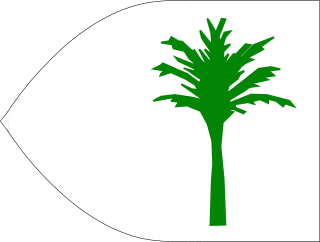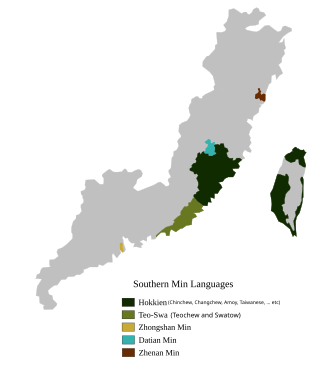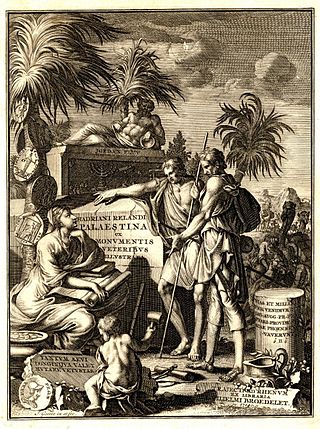Related Research Articles

The Kanem–Bornu Empire existed in areas which are now part of Nigeria, Niger, Cameroon, Libya and Chad. It was known to the Arabian geographers as the Kanem Empire from the 8th century AD onward and lasted as the independent kingdom of Bornu until 1900.

The history of Yemen describes the cultures, events, and peoples of what is one of the oldest centers of civilization in the Near East. Its relatively fertile land and adequate rainfall in a moister climate helped sustain a stable population, a feature recognized by the ancient Greek geographer Ptolemy, who described Yemen as Eudaimon Arabia meaning "fortunate Arabia" or "Happy Arabia". Yemenis had developed the South Arabian alphabet by the 12th to 8th centuries BC, which explains why most historians date all of the ancient Yemeni kingdoms to that era.

Canaan was a Semitic-speaking civilization and region of the Southern Levant in the Ancient Near East during the late 2nd millennium BC. Canaan had significant geopolitical importance in the Late Bronze Age Amarna Period as the area where the spheres of interest of the Egyptian, Hittite, Mitanni, and Assyrian Empires converged or overlapped. Much of present-day knowledge about Canaan stems from archaeological excavation in this area at sites such as Tel Hazor, Tel Megiddo, En Esur, and Gezer.
Gandhara was an ancient Indo-Aryan civilization centred in present-day north-west Pakistan and north-east Afghanistan. The core of the region of Gandhara was the Peshawar and Swat valleys extending as far east as the Pothohar Plateau in Punjab, though the cultural influence of Greater Gandhara extended westwards into the Kabul valley in Afghanistan, and northwards up to the Karakoram range. The region was a central location for the spread of Buddhism to Central Asia and East Asia with many Chinese Buddhist pilgrims visiting the region.

Greek Muslims, also known as Grecophone Muslims, are Muslims of Greek ethnic origin whose adoption of Islam dates to the period of Ottoman rule in the southern Balkans. They consist primarily of descendants of Ottoman-era converts to Islam from Greek Macedonia, Crete, and northeastern Anatolia.

Gjergj Kastrioti, commonly known as Skanderbeg, was an Albanian feudal lord and military commander who led a rebellion against the Ottoman Empire in what is today Albania, North Macedonia, Greece, Kosovo, Montenegro, and Serbia.

Hokkien is a variety of the Southern Min languages, native to and originating from the Minnan region, in the southeastern part of Fujian in southeastern mainland China. It is also referred to as Quanzhang, from the first characters of the urban centers of Quanzhou and Zhangzhou.
Jorgucat is a village in Gjirokastër County, southern Albania. At the 2015 local government reform it became part of the municipality of Dropull. It is inhabited solely by Greeks.
From the time of Muhammad, the final prophet of Islam, many Muslim states and empires have been involved in warfare. The concept of Jihad, the religious duty to struggle, has long been associated with struggles for promoting a religion, although some observers refer to such struggle as "the lesser jihad" by comparison with inner spiritual striving. Islamic jurisprudence on war differentiates between illegitimate and legitimate warfare and prescribes proper and improper conduct by combatants. Numerous conquest wars as well as armed anti-colonial military campaigns were waged as jihads.

This article presents a list of notable historical references to the name Palestine as a place name for the region of Palestine throughout history. This includes uses of the localized inflections in various languages, such as Arabic Filasṭīn and Latin Palaestina.

Shkodër is the fifth-most-populous city of the Republic of Albania and the seat of Shkodër County and Shkodër Municipality. Shkodra has been continuously inhabited since the Early Bronze Age, and has roughly 2,200 years of recorded history. The city sprawls across the Plain of Mbishkodra between the southern part of Lake Shkodër and the foothills of the Albanian Alps on the banks of the Buna, Drin and Kir rivers. Due to its proximity to the Adriatic Sea, Shkodër is affected by a seasonal Mediterranean climate with continental influences.
Armenis, in Italian and older English literature Armeni, is a Greek family from Corfu. The Armeni family is an ancient Byzantine-, and later Greco-Venetian gens that produced many important individuals in the history of Europe. With origins in Byzantium, the family achieved levels of wealth and prominence over the centuries in branches found across the territories of modern Greece and Italy. The Armeni are listed in numerous registers of nobility, including Teatro della Nobiltà dell'Europa, ovvero notizia delle famiglie nobili, che in Europa vivono di presente, e che in lei vissero prima (1725), Origine de' cognomi gentilizi nel Regno di Napoli (1756), Dictionnaire Historique et Généalogique des Grandes Familles de Grèce, d'Albanie et de Constantinople (1983), Livre d'Or de la Noblesse Ionienne (1925), and La Dalmazia Giornale Letterario Economico Inteso Agli Interessi Della Provincia, Volume 2 (1846), among others.

The history of East Africa has been divided into its prehistory, the major polities flourishing, the colonial period, and the post-colonial period, in which the current nations were formed. East Africa is the eastern region of Africa, bordered by North Africa, Central Africa, Southern Africa, the Indian Ocean, and the Sahara Desert. Colonial boundaries are reflected in the modern boundaries between contemporary East African states, cutting across ethnic and cultural lines, often dividing single ethnic groups between two or more states.
References
- ↑ Torday, Emil; Joyce, Thomas Athol (1910). Notes ethnographiques sur les peuples communément appelés Bakuba, ainsi que sur les peuplades apparentées. Les Bushongo (in French). pp. 17–19.
- 1 2 Aderinto, Saheed (2017-08-24). African Kingdoms: An Encyclopedia of Empires and Civilizations. Bloomsbury Publishing USA. ISBN 979-8-216-04343-0.
- 1 2 3 4 5 6 7 8 9 10 11 12 13 14 15 16 17 18 19 20 21 22 23 24 25 26 27 28 29 30 31 32 33 34 35 36 37 38 LaGamma, Alisa (2011). Heroic Africans: Legendary Leaders, Iconic Sculptures. Metropolitan Museum of Art. p. 165. ISBN 978-1-58839-432-3.